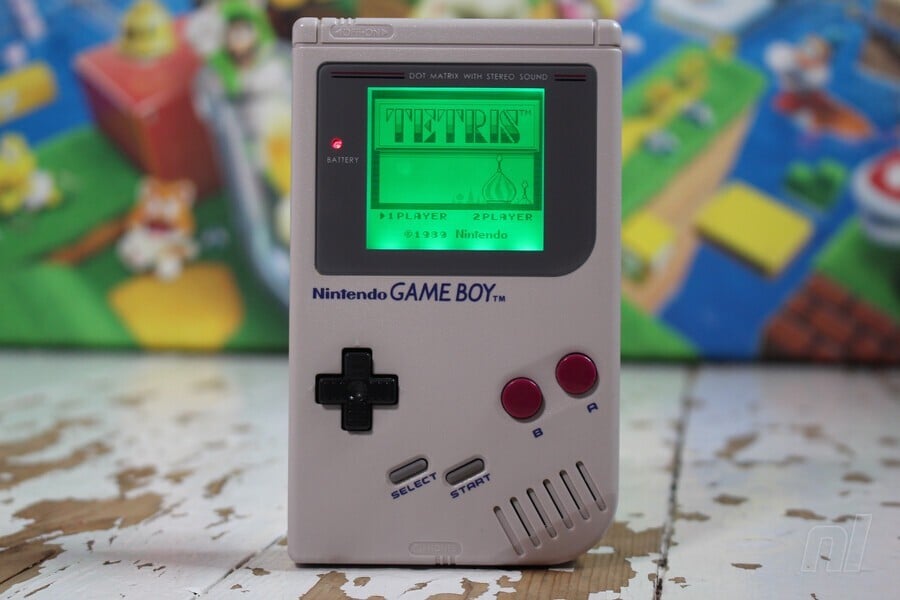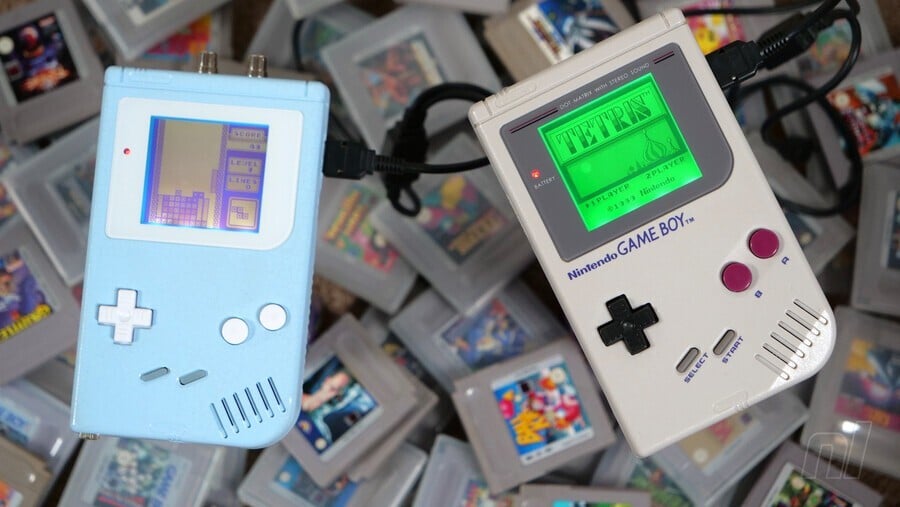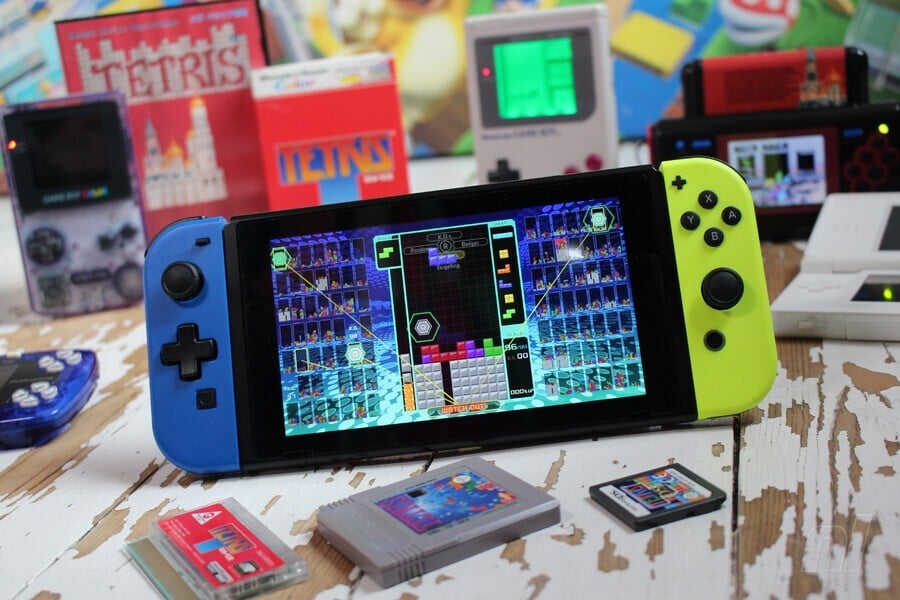

Soapbox features enable our individual writers and contributors to voice their opinions on hot topics and random stuff they’ve been chewing over. Today, Tim thinks back on 35 years of Tetris on the Game Boy and considers how it taught a generation — multiple generations, in fact — how to play these new-fangled vidyagames…
Everyone has to start their gaming journey somewhere. For an entire generation, that gateway was Tetris for Game Boy.
This nascent entry in the block-dropping puzzler franchise was to Nintendo’s inaugural handheld as Mario Kart 8 Deluxe is to Switch, which is to say that if you owned a Game Boy, you were statistically likely to own Tetris. This can be attributed in large part to the game being a pack-in until 1993 in North America and Europe, ensuring it was the first cartridge most people would slot into their Game Boy upon unboxing it.
Angling Tetris to be new players’ first-ever game was a stroke of genius on Nintendo’s part. Video games—particularly those that utilized what we now consider a traditional controller layout—were still relatively new concepts in 1989. For context: the D-pad was put to market on a Nintendo device only seven years prior with the Donkey Kong Game & Watch. Even with the NES making waves in the interim, the general public was still coming to grips with moving through two-dimensional digital spaces with a combination of directional and button presses.

Given that Tetris requires naught but basic inputs to pilot, it was the perfect vessel for teaching people of all ages how to play video games. To this end, it was the ideal game to guarantee that everyone owned from the outset. This was particularly important for a handheld owned by many kids who may never have touched a controller before but likely would’ve opted for Mario over geometry if purchasing cartridges à la carte.
We often take for granted how difficult it is for someone who isn’t game literate to understand basic gameplay fundamentals.
I can vouch for its tutorial qualities, as Tetris for Game Boy was my younger self’s first game (albeit, in the mid-’90s) and it got me started with the gaming know-how and motor functions I’ve utilized to this day. Let me walk you through the process of exactly how the game taught me and other players of the time how to game.
Existing prior to the expanded feature set people know from later Tetris entries, the Game Boy iteration’s controls boiled down to two types of input: moving tetrominos across an invisible grid with the D-pad and pressing the ‘A’ and ‘B’ buttons to rotate them 90° clockwise or counter-clockwise. This meant that every button (save for ‘Up,’ which I’ll touch on later) provided instant and easily discerned feedback, with a clear delineation between their functions. By comparison, Super Mario Land—the other major Game Boy launch window release—required more complex combinations of button presses to navigate. By assigning exactly one task to every button and not requiring any multi-button combinations, Tetris taught itself so well that it wasn’t necessary to read the manual (which kids were likely to pass over).
At this point, the hard part is done. The player can functionally play the game, a foundation upon which they’ll naturally build dexterity and speed with practice. However, they still might not be quite ready for the more complex inputs and abstract game concepts of Super Mario Land.
We often take for granted how difficult it is for someone who isn’t game-literate to understand basic gameplay fundamentals. Speaking to my own experience as a kid with a Game Boy, I struggled to overcome King Totomesu’s fireballs in Super Mario Land on the off-chance I even reached him and needed a neighbor to help me get past the old man in Viridian City at the start of Pokémon Red and Blue (this same neighbor would go on to scare the life out of me by summoning MissingNo.). Yet Tetris never confronted me with any such roadblocks given the game’s roots in an early childhood toy familiar to any kid: building blocks.
By grounding gameplay in the real-life concept of stacking objects that kids learn from toddler play, a general understanding of what’s occurring on-screen is baked in. Perhaps most kids won’t immediately understand that they need to fill up rows with blocks, though enough random tetromino dropping will inevitably lead to a line-clear, probably even during the control learning process. The game makes great fanfare of this event by pausing the action, flashing the cleared lines, playing a sound effect, and increasing your score, lines cleared, and level. Every possible indicator is given to signal that you’ve succeeded, even if by accident at first.

Once the connection between the player’s action and the win state is made, the floodgates open for formulating optimal brick patterns, sliding them into tight spots, and recovering from mistakes. In the process, the inputs for moving and rotating tetromino mesh together into one fluid motion, paving the way for control schemes that ask more of the player. The rest is history; you’re a lifelong gamer now, kiddo.
would we be here without the skills that 1989 entry endowed upon a generation of gamers, and how it launched Tetris’ popularity into the stratosphere?
It’s important to emphasize that Tetris for Game Boy was so successful as a teaching mechanism because of its simplicity compared to later titles. For example, while the ability to hold a tetromino for deployment at an opportune moment massively increased the formula’s strategic depth, its absence here worked in favor of providing a simpler framework that never risked overwhelming the player with mechanics. A function like this could’ve been mapped to ‘Up’ but would’ve led to undue confusion at a time when gaming was still new to most people. Similarly, if ‘Up’ initiated a hard drop it would have likely been more jarring to the layman than the button having no function.
These features absolutely make for more compelling modern Tetris games. Even the most nostalgic gamers would be hard-pressed not to cede that the likes of Tetris Effect and Tetris 99 are superior to the franchise’s simpler times. However, these and other updated arcade classics can afford these complexities as the language of controlling games has been deeply embedded within our culture; most kids understand digital interfaces by the time they can hold a controller.

New Tetris games thus meet the needs of their generation of players, just as Tetris for Game Boy did for ‘80s and ‘90s kids like me. But would we be here without the skills that 1989 entry endowed upon a generation of gamers, and more broadly how it launched Tetris’ popularity into the stratosphere? It’s worth remembering this seminal entry for the special place it holds in gaming history as we celebrate its 35th anniversary.
And hey, why not give it a look on the Nintendo Switch Online Game Boy app, even if just to hear that iconic banger of a theme?
Is there a specific Tetris game that played an important role in your life? Let us know in the comments.

Soapbox features enable our individual writers and contributors to voice their opinions on hot topics and random stuff they’ve been chewing over. Today, Tim thinks back on 35 years of Tetris on the Game Boy and considers how it taught a generation — multiple generations, in fact — how to play these new-fangled vidyagames…
Everyone has to start their gaming journey somewhere. For an entire generation, that gateway was Tetris for Game Boy.
This nascent entry in the block-dropping puzzler franchise was to Nintendo’s inaugural handheld as Mario Kart 8 Deluxe is to Switch, which is to say that if you owned a Game Boy, you were statistically likely to own Tetris. This can be attributed in large part to the game being a pack-in until 1993 in North America and Europe, ensuring it was the first cartridge most people would slot into their Game Boy upon unboxing it.
Angling Tetris to be new players’ first-ever game was a stroke of genius on Nintendo’s part. Video games—particularly those that utilized what we now consider a traditional controller layout—were still relatively new concepts in 1989. For context: the D-pad was put to market on a Nintendo device only seven years prior with the Donkey Kong Game & Watch. Even with the NES making waves in the interim, the general public was still coming to grips with moving through two-dimensional digital spaces with a combination of directional and button presses.

Given that Tetris requires naught but basic inputs to pilot, it was the perfect vessel for teaching people of all ages how to play video games. To this end, it was the ideal game to guarantee that everyone owned from the outset. This was particularly important for a handheld owned by many kids who may never have touched a controller before but likely would’ve opted for Mario over geometry if purchasing cartridges à la carte.
We often take for granted how difficult it is for someone who isn’t game literate to understand basic gameplay fundamentals.
I can vouch for its tutorial qualities, as Tetris for Game Boy was my younger self’s first game (albeit, in the mid-’90s) and it got me started with the gaming know-how and motor functions I’ve utilized to this day. Let me walk you through the process of exactly how the game taught me and other players of the time how to game.
Existing prior to the expanded feature set people know from later Tetris entries, the Game Boy iteration’s controls boiled down to two types of input: moving tetrominos across an invisible grid with the D-pad and pressing the ‘A’ and ‘B’ buttons to rotate them 90° clockwise or counter-clockwise. This meant that every button (save for ‘Up,’ which I’ll touch on later) provided instant and easily discerned feedback, with a clear delineation between their functions. By comparison, Super Mario Land—the other major Game Boy launch window release—required more complex combinations of button presses to navigate. By assigning exactly one task to every button and not requiring any multi-button combinations, Tetris taught itself so well that it wasn’t necessary to read the manual (which kids were likely to pass over).
At this point, the hard part is done. The player can functionally play the game, a foundation upon which they’ll naturally build dexterity and speed with practice. However, they still might not be quite ready for the more complex inputs and abstract game concepts of Super Mario Land.
We often take for granted how difficult it is for someone who isn’t game-literate to understand basic gameplay fundamentals. Speaking to my own experience as a kid with a Game Boy, I struggled to overcome King Totomesu’s fireballs in Super Mario Land on the off-chance I even reached him and needed a neighbor to help me get past the old man in Viridian City at the start of Pokémon Red and Blue (this same neighbor would go on to scare the life out of me by summoning MissingNo.). Yet Tetris never confronted me with any such roadblocks given the game’s roots in an early childhood toy familiar to any kid: building blocks.
By grounding gameplay in the real-life concept of stacking objects that kids learn from toddler play, a general understanding of what’s occurring on-screen is baked in. Perhaps most kids won’t immediately understand that they need to fill up rows with blocks, though enough random tetromino dropping will inevitably lead to a line-clear, probably even during the control learning process. The game makes great fanfare of this event by pausing the action, flashing the cleared lines, playing a sound effect, and increasing your score, lines cleared, and level. Every possible indicator is given to signal that you’ve succeeded, even if by accident at first.

Once the connection between the player’s action and the win state is made, the floodgates open for formulating optimal brick patterns, sliding them into tight spots, and recovering from mistakes. In the process, the inputs for moving and rotating tetromino mesh together into one fluid motion, paving the way for control schemes that ask more of the player. The rest is history; you’re a lifelong gamer now, kiddo.
would we be here without the skills that 1989 entry endowed upon a generation of gamers, and how it launched Tetris’ popularity into the stratosphere?
It’s important to emphasize that Tetris for Game Boy was so successful as a teaching mechanism because of its simplicity compared to later titles. For example, while the ability to hold a tetromino for deployment at an opportune moment massively increased the formula’s strategic depth, its absence here worked in favor of providing a simpler framework that never risked overwhelming the player with mechanics. A function like this could’ve been mapped to ‘Up’ but would’ve led to undue confusion at a time when gaming was still new to most people. Similarly, if ‘Up’ initiated a hard drop it would have likely been more jarring to the layman than the button having no function.
These features absolutely make for more compelling modern Tetris games. Even the most nostalgic gamers would be hard-pressed not to cede that the likes of Tetris Effect and Tetris 99 are superior to the franchise’s simpler times. However, these and other updated arcade classics can afford these complexities as the language of controlling games has been deeply embedded within our culture; most kids understand digital interfaces by the time they can hold a controller.

New Tetris games thus meet the needs of their generation of players, just as Tetris for Game Boy did for ‘80s and ‘90s kids like me. But would we be here without the skills that 1989 entry endowed upon a generation of gamers, and more broadly how it launched Tetris’ popularity into the stratosphere? It’s worth remembering this seminal entry for the special place it holds in gaming history as we celebrate its 35th anniversary.
And hey, why not give it a look on the Nintendo Switch Online Game Boy app, even if just to hear that iconic banger of a theme?
Is there a specific Tetris game that played an important role in your life? Let us know in the comments.








